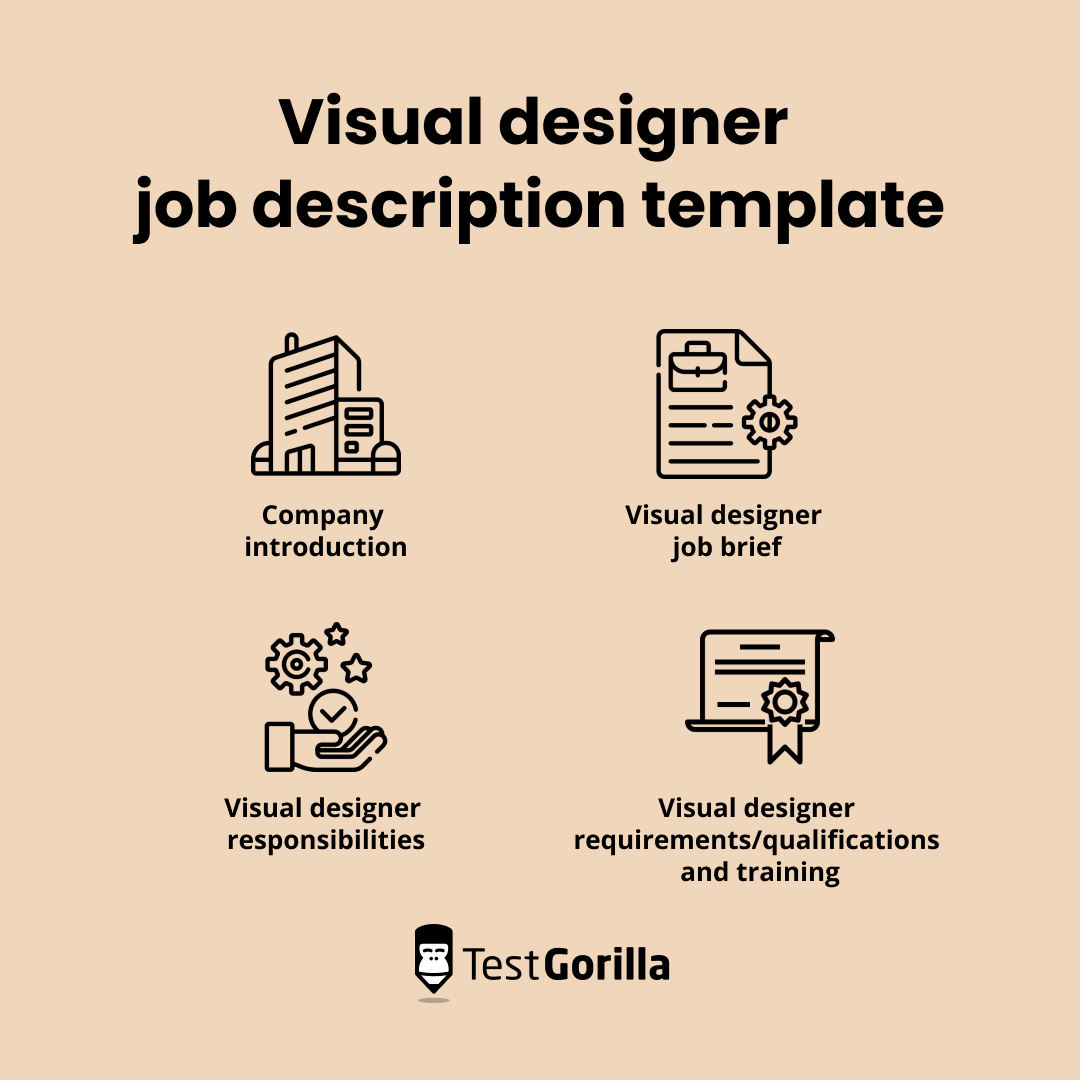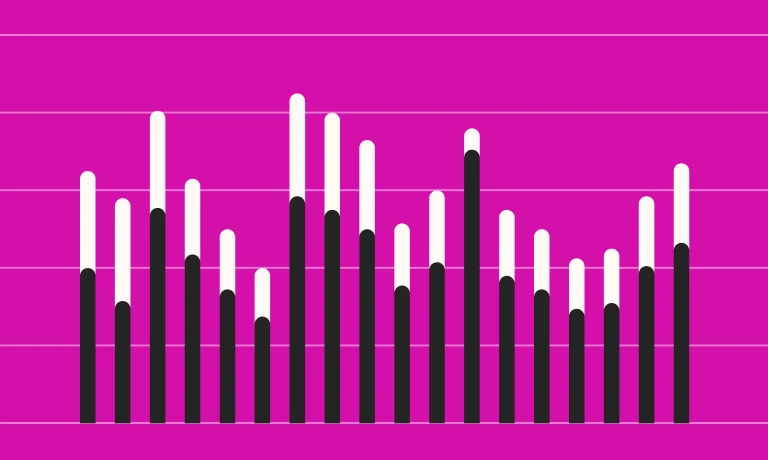Writing a thorough visual designer job description is the first step to finding your next great hire. Without one, mismatched or unqualified candidates may apply to your open position. This can cost you and your recruitment team precious time identifying qualified candidates from the applicant pool.
To help you avoid this problem, we’ve put together this handy guide. It covers everything you need to know about writing a visual designer job description, including key skills to consider and common pitfalls to avoid. We also share a free job description template.
Table of contents
- What is a visual designer job?
- Key skills to look for in a visual designer
- How to write an effective visual designer job description
- Visual designer job description template
- 3 things to avoid when writing a job description for visual designers
- Next steps: Attracting and assessing visual designer candidates
- FAQs
- Find your next visual designer with TestGorilla
What is a visual designer job?
A visual designer specializes in creating aesthetic and on-brand marketing materials for your business. This includes designing websites, brochures, social media graphics, and more.
Visual designers help shape your brand’s identity by picking the right colors, typography, and graphics to use in materials to engage your audience.
Key skills to look for in a visual designer
To hire the best designer for your team, you need to know the essential skills they should have. Strong visual designers will demonstrate:
Creativity. Visual designers should be able to produce creative, memorable design campaigns from content briefs.
Illustration skills. Custom illustrations can be invaluable in visual design. Measuring a candidate's illustration skills can help you understand their traditional skills, originality, and how they take and work with revisions.
Design software skills. Candidates should be familiar with the design software your company uses – for example, Adobe Illustrator and Photoshop.
An understanding of color theory. Designers must understand how color affects their work and the technical aspects of color, including color modes (e.g., RGB and CMYK) and color profiles.
Knowledge of branding techniques. Visual designers should understand basic branding techniques, including how to craft a cohesive brand identity across various design materials.
Knowledge of typography. Candidates should possess strong typography skills and knowledge, including how typography can enhance readability and add to brand image.
Attention to detail. Small mistakes can negatively impact a final product and, in some cases, completely change the intended message or branding. Visual designers should have strong attention to detail to prevent this.
Problem solving skills. Challenges are common during the design process. Visual designers should be able to navigate them with creativity and resourcefulness.
Industry awareness. The best designers know what’s happening in the industry. They’ll keep up with popular design trends, competitor campaigns, emerging technologies, and more.
In addition, visual designers should have a portfolio that showcases their creative work. You can ask designers to upload digital copies of their portfolios during the application process or before a video interview. Or, you can require them to bring their portfolios to an in-person interview later on.
The best insights on HR and recruitment, delivered to your inbox.
Biweekly updates. No spam. Unsubscribe any time.
How to write an effective visual designer job description
There are several ways to create a visual designer job description that’s both engaging and effective. We’ve highlighted three especially useful tips below.
Define what you need in a visual designer
Before writing your job description, determine the skills you need in a visual designer based on your current projects and objectives. For example, will the designer be involved in rebranding a product? If so, they’ll need a strong knowledge of branding techniques.
You should also consider your existing team’s skills. Are there any gaps in skills or knowledge you’re looking to fill? For example, if your employees are skilled in color theory and typography but struggle to hit deadlines, include “strong time management skills” in your job description.
Use bias-free language
Avoid gender-specific pronouns or terms in your job descriptions, as these can discourage some individuals from applying. For instance, use neutral language like “the visual designer will be responsible for…” or “they will oversee…” rather than “he” or “she.” Likewise, exclude gendered terms like “visual design ninja” in favor of “visual design professional.”
Similarly, avoid language that implies you’re after applicants from a certain demographic. For example, writing that you’re seeking someone “young and energetic” who “works hard and plays hard” suggests you won’t consider older applicants.
Compare your job description to your competitors
Lastly, compare your visual designer job description to ones posted by other employers in your industry.
Check out their postings on LinkedIn or other job boards. Then, compare the job requirements and salary and benefits offered to applicants. Are your competitors focusing too much on academic experience? Do they not disclose salary details? Use this information to adjust your description to draw in top talent.
Visual designer job description template
To make creating a visual designer job description easier, we’ve included a template below.
Company introduction
Here, you should briefly discuss your company’s history, business areas, core values, and mission.
You should also highlight the benefits of working with your company. Mention competitive salaries, a supportive company culture, monetary and non-monetary rewards, health benefits, paid time off, and other perks.
Visual designer job brief
[Company name]
Job title: [E.g., Junior Visual Designer, Visual Designer, Senior Visual Designer]
Reports to: [For instance, Head of Visual Design]
Job type: [Full-time, part-time, on-site, remote, or hybrid]
[Compensation information, including salary and benefits]
Visual designer responsibilities
Develop and design assets – including social media graphics, web landing pages, and infographics – that align with company branding
Establish cohesive color schemes, typography sets, and visual styles for various projects, ensuring they align with brand expectations and objectives
Use Adobe InDesign and Photoshop to create designs and typography for assets
Communicate and collaborate with user experience (UX) and user interface (UI) designers, software developers, and stakeholders to ensure project success
Visual designer requirements/qualifications and training required
Bachelor’s or master’s degree in visual design, visual arts, graphic design, or a related field (or equivalent work experience)
Proficiency in Adobe Creative Suite (Photoshop, Illustrator, and InDesign)
2+ years experience as a visual designer or graphic designer
3 things to avoid when writing a job description for visual designers
There are a few things to avoid to ensure your visual designer job description captures candidates’ attention. Below, we’ve highlighted three common pitfalls and how to avoid them.
1. Too many “essential” skills
Avoid listing excessive qualifications or skills as being essential for the role. Instead, focus primarily on the must-haves, like experience using design software. Then, include a short list of preferred skills, like project management experience or graphic design skills.
2. Using buzzwords
Be specific in your language when creating a job description for a visual designer. For example, terms like “creative thinker” or “team player” are too broad and don't provide clear expectations.
Instead, list the detailed skills and qualities you seek. For instance, you might write that you’re looking for “an experienced visual designer with a proven ability to collaborate across design and development teams.”
3. Overemphasis on academic qualifications
While education is valuable, many talented designers honed their skills through practical experience instead of academia. Avoid listing a bachelor’s or master’s degree as a requirement and instead note that applicants can have either an academic qualification or equivalent work experience.
Next steps: Attracting and assessing visual designer candidates
Once you’ve crafted a high-quality job description, the next step is attracting and assessing visual design candidates.
First, upload your job description to multiple job posting platforms – for example, LinkedIn, Indeed, and Behance (which is specifically for designers). You could also try using Reddit and freelancer platforms like Upwork or Fiverr to help you find great creative talent.
After you’ve gathered and sorted through applications, assess your candidates using TestGorilla’s range of pre-employment tests. Combine up to five tests (from a library of 300+) for a custom assessment that measures various hard and soft skills. You can also add your own questions for an even more tailored evaluation.
Consider using the following tests to assess your design candidates:
Role-specific skills tests, like TestGorilla’s SketchUp Pro or Adobe InDesign test, to assess candidates’ proficiency in design software
Our Culture add test to determine how well a candidate will mesh with your current team and what they might add to your company culture
TestGorilla’s Attention to Detail (Visual) test to ensure designers are meticulous in their work and can spot small errors
Personality tests, like the Big 5 (OCEAN) or Enneagram test, to evaluate candidates’ behavioral traits and see if they’ll work well with your existing team
FAQs
Is a visual designer a UX designer?
Visual designers and UX designers share some responsibilities and may work closely together. However, they’re distinct roles. Visual designers are concerned with the overall look of a design. Meanwhile, UX designers ensure the design provides a great user experience.
What is the role of a visual designer?
A visual designer creates on-brand and visually attractive materials to advertise a business, service, or product. Materials can be in print format, such as in a magazine, or digital format, like on a website.
Find your next visual designer with TestGorilla
You’ll need a well-written job description to attract great visual design applicants. It should include the job title, an introduction to your company, job requirements, desirable qualifications, and more. This will help potential applicants understand exactly what you’re looking for and evaluate if they fit the bill.
Once you’ve gathered applications, you can assess candidates’ skills using TestGorilla’s pre-employment assessments. These tools give you powerful insights into candidates’ skills, abilities, and personality types to help you make data-driven hiring decisions. Plus, TestGorilla can simplify your hiring process by benchmarking candidates against one another for easy comparison.
Get started with TestGorilla today by signing up for our free plan.
You've scrolled this far
Why not try TestGorilla for free, and see what happens when you put skills first.



















